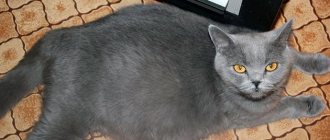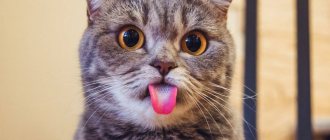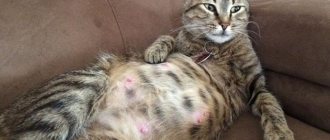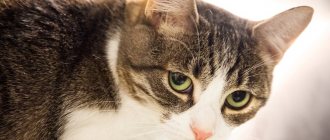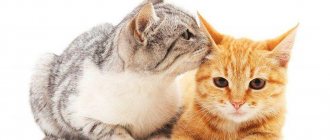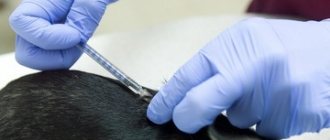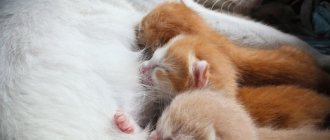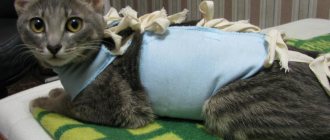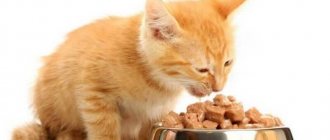Cats are surprisingly “active” and productive animals. It is known that one animal can have about 200 kittens in its entire life; cases have also been described when a cat gave birth to more. What is the reason for this fertility? Largely due to the fact that childbirth in a cat does not mean inhibition of reproductive function. If there is a cat nearby, the female may begin sexual heat almost the next day after the kittens are born!
General information
So, as we have already indicated above, cats belong to the category of very prolific animals. More precisely, small cats. This is not surprising, since the species tries to maintain its optimal numbers in this way. If you look at “orphan” animals, then without any surprise you can reveal that out of a dozen kittens born, barely two or three individuals survive to the age of one year . And this is in the relatively comfortable conditions of modern megacities, where homeless cats have no problems with food.
In more severe natural conditions, “debit and credit” may generally converge in a negative proportion. Predators, climate, and other unfavorable factors can lead to the death of not only the entire litter, but also the mother herself. All this leads to the fact that the cat’s body is programmed by nature for maximum productivity. It is for this reason that the cat begins to walk (or rather, can begin) almost immediately after giving birth.
But if in natural conditions such fertility is more than justified, then in domestic conditions it is not so much. Moreover, this leads to numerous problems, which we will write about below.
The main signs of a cat's heat
To prevent the pet from taking its owners by surprise, it is recommended to familiarize yourself with the signs of estrus in advance. The owner will immediately notice changes in the pet’s behavior, and drastic ones at that.
A walking cat is prone to affection
During heat, the cat becomes restless and sleeps less. She becomes overly affectionate, rubbing herself against her owners or furniture. During this period, the owner will definitely hear a piercing meow, loud rumbling or purring. All this is accompanied by a raised or sideways tail and an arched back. In the last few days, the cat may begin to squat, roll on its back, or lift its butt. The cat walks differently.
Note! Estrus is divided into three periods - proestrus, estrus and metestrus. Each of them takes from 2 to 5 days. Behavior changes depending on the stage of estrus.
There is no need to be afraid of loss of appetite; this is a common symptom when a cat is walking. The most active ones may scratch the walls or attempt to escape from the house to the street. The animal will be ready for mating only on days 2-4, when the estrus period begins. Only at this stage will she let the cat near her. If fertilization has occurred, then during the metestrus stage all instincts will disappear: she will stop screaming and worrying.
Despite the fact that estrus is usually accompanied by bouts of affection and tenderness towards the owner, it is stressful for the animal, especially for the first time. A pet who is walking for the first time may show causeless aggression towards others. Her emotional state leaves much to be desired: anxiety and irritability affect her behavior. In some individuals, the state of tenderness and complaisance will periodically be replaced by attacks of anger throughout estrus.
What are the risks of constant pregnancy?
Exclusively by an increase in the number of stray animals (in the case of stray cats), as well as depletion of the mother’s body (in the case of “industrial” reproduction). In general, constant pregnancy is harmful for cats . After all, you and your pet do not live in the jungle, where kittens and cats can be eaten at any moment, so such high fertility only causes a lot of problems.
Interesting fact: frequent postpartum heats are typical for cats whose litters constantly contain “rejected”, underdeveloped kittens.
Moreover, in such cases, the mother often eats the entire litter and immediately begins to “hunt” for the cats. This is also a physiologically based phenomenon. If an animal feels that the offspring has “failed,” its body tries with all its might to fulfill the reproductive function assigned to it. That is, get rid of an unnecessary brood and urgently get pregnant again.
Natural food products
Products are chosen fresh, rich in proteins, calcium, carbohydrates and beneficial elements.
Among them:
- boiled lean meat: chicken, beef, rabbit, turkey, veal;
- vegetables: beets, pumpkin, cauliflower, carrots, zucchini;
- cottage cheese, curdled milk, natural yoghurts, biokefir;
- cereals: buckwheat, oatmeal, sprouted wheat grains.
To reduce the risk of developing constipation due to intestinal problems, add to the main diet:
- low-fat broths in which meat was cooked;
- warm milk (in small quantities);
- 3 – 4 drops of flaxseed, olive, sesame oil (added to food);
- boiled beets or puree from them;
- young shoots of oats, wheat, barley.
Approximate diet
In the second week of pregnancy, the cat’s appetite increases, therefore the amount of food is increased by 10% of the previous volume, from the second month - by 50%. In the last weeks before childbirth, appetite decreases, it is recommended to reduce portions, and the number of feedings is calculated based on the needs of the expectant mother. An adult animal needs 180-200 grams per day to be satisfied.
Is it possible to prevent postpartum sexual desire?
In principle, heat immediately after birth is not a very typical case, and we would recommend showing such a cat to a veterinarian. But estrus may well be triggered by irritants from the external environment. The main factor is the presence of a cat nearby. Sometimes even the company of a long-neutered and completely “incompetent” pet is enough. Thus, in cases where you have several pets of different sexes at home, the cat after giving birth must be isolated from them in a separate room.
In addition, try to minimize the effect of stress factors on your pet. Protect her from sharp and loud sounds and smells, and do not start renovations at home at least until the kittens begin to feed on their own. Otherwise, the cat’s body may “wedge” and she will decide that the cubs, being in “mortal danger,” are doomed anyway. And therefore she can leave them and start walking again.
Quality nutrition plays an important role. If the animal’s body receives all the nutrients, micro- and macroelements, then there will be no problems with the kittens’ nutrition . But in the opposite cases, everything is much worse. When a cat’s body “feels” that it is “not up to the task” of feeding kittens, a biological mechanism can come into play, the essence and results of which we have already written about several times above. So it is in your best interests to feed your newborn pet normally.
Number of births per year
Veterinarians and breeders (people involved in breeding new breeds) are confident that a normal animal should not give birth more than 1.5 times every 3 years . This means that on average a cat should not have more than one birth per year.
Otherwise, the pet will quickly become exhausted, and the body will be subject to various pathological processes. Life expectancy decreases, each subsequent offspring will be weak, painful and non-viable. A cat may develop malignant neoplasms in the mammary glands and genitals.
What to do if your pet goes on a spree?
Firstly, be mentally prepared for the need to feed kittens on your own. Practice, unfortunately, proves that such cats almost always lose milk. This is due to a sharp change in hormonal levels. The released compounds block the synthesis of prolactin, that is, the hormone responsible for milk production. Accordingly, the kittens are left without their natural food.
Let us immediately warn you that you should never use cow or goat milk to feed babies, since their characteristics are very different from cat milk and often cause severe digestive disorders. And for small kittens the latter are deadly.
Secondly, under no circumstances use hormonal medications to stop estrus . The body of an animal that has gone into heat immediately after birth is already experiencing powerful overloads. There is no need to aggravate the matter with an influx of “third-party” hormones of synthetic origin. In such cases, the matter may end in oncology.
Consult your veterinarian and choose more gentle sedative drugs on a natural basis. They will allow you and your cat to safely survive the hunting period.
Normal discharge
After the birth of kittens, the owner must carefully monitor the temperature and discharge of his pet. The birth of kittens ends with discharge. Initially they may be brown or streaked with blood - this is normal.
Postpartum discharge from the loop is an integral part of the body’s recovery. After childbirth, the uterus contracts and expels clear mucus residue. This can last up to three weeks. Veins and a greenish tint in some cases can be considered normal, and in some cases they can be life-threatening. Here you will need the help of a doctor.
Laxatives
A laxative during breastfeeding is necessary to provide immediate assistance to yourself. However, some remedies help normalize intestinal function in general. To understand the mechanism of their work, consider all groups of laxatives:
- stimulating;
- volumetric;
- osmotic;
- softening.
The first act on intestinal receptors. They are addictive and can cause complications such as lazy bowel syndrome. In addition, taking stimulant laxatives is not allowed during lactation, so the doctor will not recommend using drugs from this group.
Osmotic drugs do not pass into breast milk and are not addictive. They are often prescribed to nursing mothers. However, a significant part of such drugs are used in coloproctology and gastroenterology as a measure of preparation for endoscopic diagnostic methods, surgical interventions, etc. They reliably cleanse the intestines, but have a pronounced effect - they can cause frequent loose stools.
Softening agents are oils, glycerin, etc. They help soften stool and simplify their movement through the intestines. However, such drugs are not approved for continuous use, since they impair the absorption of fat-soluble vitamins. This can be fraught with the development of hypovitaminosis for a young mother.
Bulk laxatives are represented by herbal or synthetic-based drugs. They act similarly to natural fiber - they are not digested in the intestines, absorb water and swell, increasing the volume of intestinal contents and softening the stool. In addition, such drugs gently stimulate intestinal motility, causing defecation. The components of such products do not pass into breast milk. They are allowed for nursing mothers and can be taken for a long time.
One such remedy is the British drug Fitomucil Norm. It contains psyllium seed hull and plum fruit extract - natural soluble and insoluble fiber. The drug gently stimulates bowel movements and promotes regular bowel function.
Physical exercise
One of the effective and affordable methods for preventing constipation in a nursing mother is light physical activity. Regular exercise will help strengthen the abdominal and perineal muscles. As a result, muscle tone increases, which helps to activate intestinal motility. Yoga, walking, swimming, and Pilates are suitable exercises for nursing mothers.
Also, don't ignore your daily warm-up. It is best to do exercises on an empty stomach. You should start with simple exercises, gradually increasing complexity. There are also specific exercises that increase intestinal contractility and help cope with constipation, for example:
- Stand straight with your feet shoulder-width apart.
- Take a deep breath, then strongly draw in and then sharply push out your stomach.
- Repeat the action 10 times and take a break.
Exercises must be performed at a slow pace, without sudden jerks. The main thing is regularity. As you get stronger, you can increase the number of repetitions. Gymnastics will help normalize bowel movements and improve your well-being.
Exercises while lying on your back
- Take a breath, stick out your stomach. As you exhale, draw in your stomach and lightly press your hands on the abdominal wall.
- Place your hands behind your head and stretch. At the same time, pull in your stomach. As you exhale, lower your arms and place them along your body.
- Lying on your back, bend your knees without lifting your heels off the floor.
- Pull your right knee towards your stomach as you exhale. Lower your leg while inhaling. Repeat the same with your left leg.
The “bicycle” and “scissors” exercises are good for constipation.
Exercises while lying on your stomach
- Place your hands under your shoulders. Get on all fours, without taking your hands off the floor, and then roll onto your feet. Take the starting position.
- Perform alternating leg swings with simultaneous retraction of the abdomen as you exhale and retraction as you inhale.
